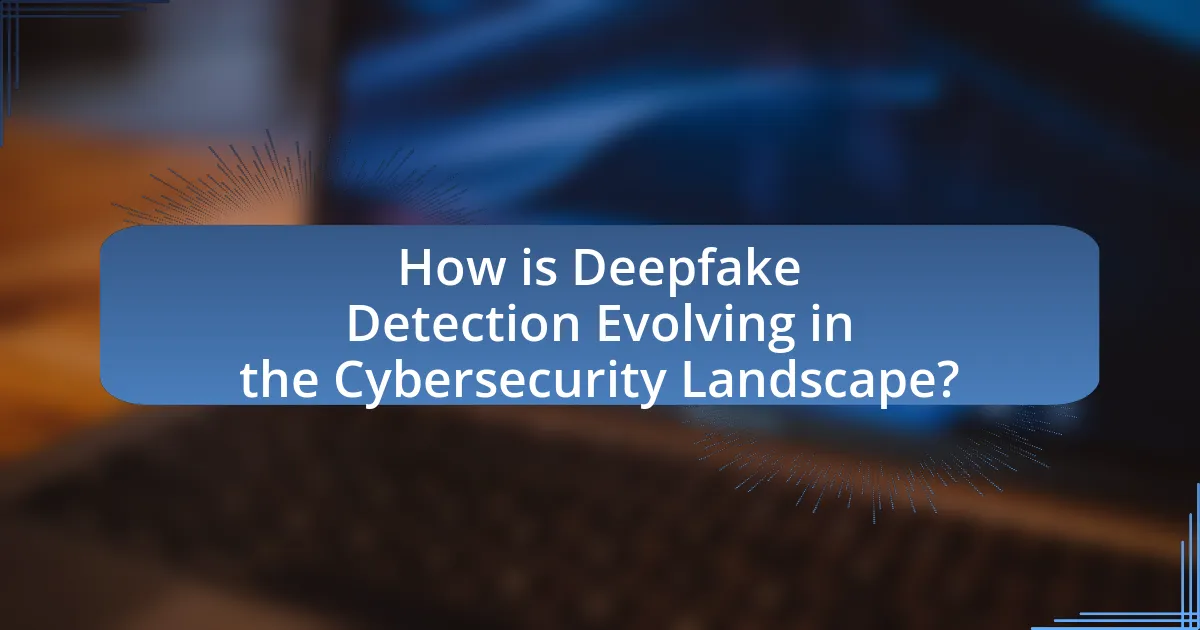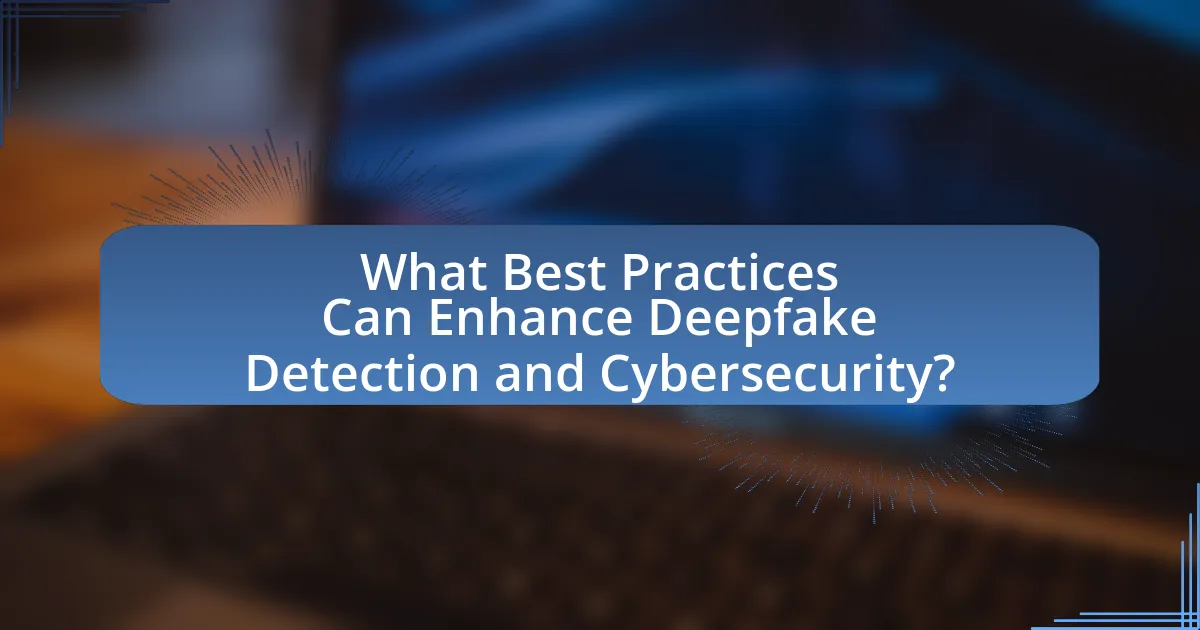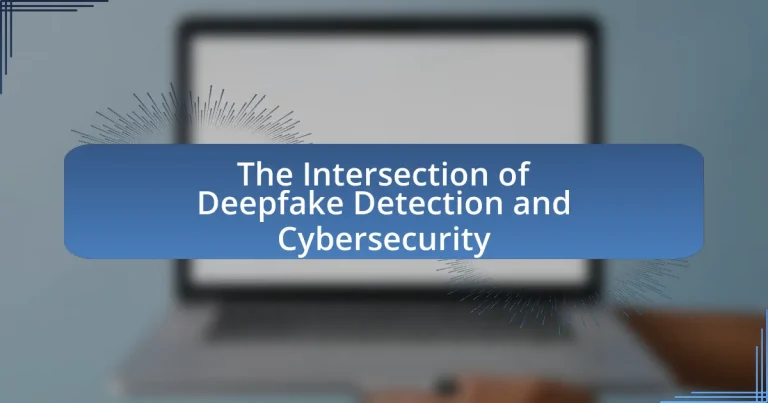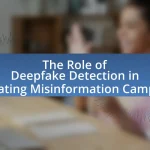The article focuses on the intersection of deepfake detection and cybersecurity, emphasizing the risks posed by deepfake technology, which can be exploited for misinformation, fraud, and identity theft. It outlines how deepfakes threaten cybersecurity by enabling the creation of convincing fake media that can manipulate individuals and organizations. The article discusses the importance of deepfake detection in preventing these threats, the technologies used in creating deepfakes, and the advancements in detection methods. Additionally, it highlights the challenges faced in deepfake detection, the role of machine learning and AI, and the proactive measures organizations can take to enhance their cybersecurity against deepfake-related risks.

What is the Intersection of Deepfake Detection and Cybersecurity?
The intersection of deepfake detection and cybersecurity lies in the need to identify and mitigate the risks posed by deepfake technology, which can be exploited for malicious purposes such as misinformation, fraud, and identity theft. Deepfake detection technologies are essential in cybersecurity frameworks to protect individuals and organizations from the potential threats that arise from manipulated media, as evidenced by incidents where deepfakes have been used to impersonate individuals in financial scams, leading to significant monetary losses. The growing sophistication of deepfake algorithms necessitates advanced detection methods, which are increasingly integrated into cybersecurity strategies to safeguard against these emerging threats.
How do deepfakes pose a threat to cybersecurity?
Deepfakes pose a significant threat to cybersecurity by enabling the creation of highly convincing fake audio and video content that can be used for malicious purposes. These manipulated media can facilitate identity theft, fraud, and misinformation campaigns, undermining trust in digital communications. For instance, a deepfake could impersonate a company executive, leading to unauthorized financial transactions or data breaches. According to a report by the Deeptrace Labs, the number of deepfake videos online increased by 84% from 2018 to 2019, highlighting the growing prevalence of this technology and its potential for exploitation in cyberattacks.
What types of deepfake technologies are commonly used?
Commonly used deepfake technologies include Generative Adversarial Networks (GANs), autoencoders, and neural networks. GANs, introduced by Ian Goodfellow in 2014, consist of two neural networks that compete against each other to create realistic images or videos, making them highly effective for generating deepfakes. Autoencoders, which compress and reconstruct data, are also utilized to swap faces in videos. Additionally, neural networks, particularly convolutional neural networks (CNNs), are employed for image synthesis and manipulation. These technologies have been widely adopted due to their ability to produce convincing and high-quality deepfake content, as evidenced by numerous applications in entertainment and social media.
How can deepfakes be utilized in cyber attacks?
Deepfakes can be utilized in cyber attacks by creating realistic but fabricated audio or video content to manipulate individuals or organizations. Attackers can use deepfakes to impersonate executives in video calls, leading to unauthorized financial transactions or data breaches. For instance, in 2019, a UK-based energy firm was tricked into transferring €220,000 to a fraudulent account after a deepfake impersonated the CEO’s voice during a phone call. This incident illustrates how deepfakes can undermine trust and facilitate social engineering attacks, making them a potent tool for cybercriminals.
Why is deepfake detection important for cybersecurity?
Deepfake detection is crucial for cybersecurity because it helps prevent the misuse of manipulated media that can lead to misinformation, fraud, and identity theft. The rise of deepfake technology has made it easier for malicious actors to create realistic but false videos or audio recordings, which can be used to deceive individuals or organizations. For instance, a study by the Deep Trust Alliance found that deepfakes could potentially cause significant financial losses and reputational damage to businesses if not detected promptly. By implementing effective deepfake detection methods, cybersecurity measures can safeguard against these threats, ensuring the integrity of information and protecting individuals from exploitation.
What are the potential consequences of undetected deepfakes?
Undetected deepfakes can lead to significant consequences, including misinformation, reputational damage, and potential security threats. Misinformation can manipulate public opinion, as seen in instances where deepfakes have been used to create false narratives during elections, undermining democratic processes. Reputational damage occurs when individuals or organizations are falsely portrayed, leading to loss of trust and financial repercussions; for example, a deepfake of a CEO making false statements can impact stock prices. Additionally, undetected deepfakes pose security threats, as they can be used in social engineering attacks to deceive individuals into revealing sensitive information, thereby compromising cybersecurity. The potential for these consequences highlights the urgent need for effective deepfake detection technologies.
How does deepfake detection enhance overall cybersecurity measures?
Deepfake detection enhances overall cybersecurity measures by identifying and mitigating the risks associated with manipulated media that can deceive individuals and organizations. The ability to detect deepfakes helps prevent social engineering attacks, misinformation campaigns, and identity theft, which are increasingly prevalent in the digital landscape. For instance, a study by MIT researchers found that deepfake detection algorithms can achieve over 90% accuracy in identifying manipulated videos, thereby reducing the potential for fraud and misinformation. By integrating deepfake detection into cybersecurity protocols, organizations can bolster their defenses against these emerging threats, ensuring the integrity of information and maintaining trust in digital communications.
What are the current challenges in deepfake detection?
Current challenges in deepfake detection include the rapid advancement of deepfake technology, which outpaces detection methods, and the increasing sophistication of algorithms used to create deepfakes. These challenges are compounded by the lack of standardized benchmarks for evaluating detection tools, leading to inconsistent performance across different systems. Additionally, the high variability in deepfake content, including diverse audio-visual styles and contexts, makes it difficult for detection algorithms to generalize effectively. Research indicates that as of 2023, detection systems struggle to maintain accuracy against evolving deepfake techniques, highlighting the need for continuous improvement and adaptation in detection methodologies.
What technological limitations exist in detecting deepfakes?
Technological limitations in detecting deepfakes include the rapid advancement of generative models, which can produce increasingly realistic content that evades detection algorithms. Current detection methods often rely on identifying artifacts or inconsistencies in the media, but as deepfake technology evolves, these artifacts become less pronounced, making detection more challenging. For instance, a study published in 2020 by Korshunov and Marcel demonstrated that state-of-the-art deepfake detection systems struggled to maintain accuracy against high-quality deepfakes, with detection rates dropping significantly as the quality of the fakes improved. Additionally, the lack of standardized datasets for training detection algorithms hampers their effectiveness, as many existing datasets do not encompass the full range of deepfake techniques.
How do adversarial attacks complicate deepfake detection?
Adversarial attacks complicate deepfake detection by introducing subtle manipulations that can evade detection algorithms. These attacks exploit vulnerabilities in machine learning models, allowing adversaries to create deepfakes that appear authentic while bypassing existing detection methods. For instance, research has shown that adversarial perturbations can be imperceptible to human observers but significantly alter the output of deepfake detection systems, making it challenging to identify manipulated content accurately. This dynamic creates an ongoing arms race between deepfake creators and detection technologies, as each side continuously adapts to the other’s advancements.

How is Deepfake Detection Evolving in the Cybersecurity Landscape?
Deepfake detection is evolving rapidly in the cybersecurity landscape due to advancements in artificial intelligence and machine learning technologies. These technologies enable the development of sophisticated algorithms that can analyze video and audio content for inconsistencies, such as unnatural facial movements or mismatched audio-visual cues. For instance, a study by the University of California, Berkeley, demonstrated that deep learning models can achieve over 90% accuracy in identifying manipulated media, highlighting the effectiveness of these methods. Additionally, cybersecurity firms are increasingly integrating deepfake detection tools into their security protocols to combat misinformation and protect against identity theft, reflecting a proactive approach to emerging threats in digital environments.
What advancements are being made in deepfake detection technologies?
Advancements in deepfake detection technologies include the development of AI algorithms that analyze inconsistencies in facial movements and audio-visual synchronization. Researchers at Stanford University have created a deep learning model that identifies deepfakes with over 90% accuracy by examining pixel-level anomalies and temporal inconsistencies. Additionally, companies like Sensity and Deeptrace are utilizing machine learning techniques to detect manipulated media in real-time, enhancing cybersecurity measures against misinformation. These advancements are crucial as deepfake technology becomes more sophisticated, necessitating equally advanced detection methods to protect against potential threats.
How are machine learning and AI contributing to detection efforts?
Machine learning and AI significantly enhance detection efforts by automating the identification of anomalies and patterns in data. These technologies analyze vast datasets quickly, enabling the detection of deepfakes and cybersecurity threats with high accuracy. For instance, machine learning algorithms can be trained on large datasets of authentic and manipulated media, allowing them to recognize subtle inconsistencies that human reviewers might miss. Research from Stanford University demonstrates that AI models can achieve over 90% accuracy in detecting deepfake videos, showcasing their effectiveness in safeguarding against misinformation and cyber threats.
What role do collaborative efforts play in improving detection methods?
Collaborative efforts significantly enhance detection methods by pooling resources, expertise, and data from various stakeholders. This collective approach allows for the development of more sophisticated algorithms and models that can better identify deepfakes and other cybersecurity threats. For instance, partnerships between tech companies, academic institutions, and government agencies have led to the creation of comprehensive datasets that improve machine learning training processes, resulting in higher accuracy rates in detection. Research indicates that collaborative frameworks, such as the Deepfake Detection Challenge, have successfully advanced the state of detection technologies by fostering innovation through shared knowledge and competitive analysis.
How are organizations adapting to the threat of deepfakes?
Organizations are adapting to the threat of deepfakes by implementing advanced detection technologies and enhancing their cybersecurity protocols. For instance, many companies are investing in artificial intelligence and machine learning tools specifically designed to identify manipulated media, with research indicating that these technologies can achieve over 90% accuracy in detecting deepfakes. Additionally, organizations are conducting regular training for employees to recognize potential deepfake content, thereby increasing awareness and vigilance. Furthermore, collaborations with cybersecurity firms and participation in industry-wide initiatives are becoming common practices to share knowledge and develop standardized detection methods.
What strategies are companies implementing to combat deepfake threats?
Companies are implementing several strategies to combat deepfake threats, including the use of advanced detection technologies, employee training programs, and collaboration with cybersecurity firms. Advanced detection technologies utilize machine learning algorithms to identify inconsistencies in audio and visual content, enabling quicker identification of deepfakes. Employee training programs educate staff on recognizing deepfake content and understanding its potential impact on the organization. Additionally, collaboration with cybersecurity firms enhances the development of robust detection tools and sharing of threat intelligence, which is crucial given that deepfake technology is rapidly evolving. These strategies collectively aim to mitigate the risks associated with deepfakes, which can lead to misinformation, reputational damage, and financial loss.
How can organizations educate employees about deepfake risks?
Organizations can educate employees about deepfake risks through comprehensive training programs that include awareness sessions, practical demonstrations, and regular updates on emerging threats. These programs should focus on identifying deepfake content, understanding its potential impact on security and reputation, and implementing verification techniques. For instance, a study by the University of California, Berkeley, highlights that training can significantly improve employees’ ability to detect manipulated media, with participants showing a 70% increase in detection accuracy after targeted education. Regular workshops and access to resources, such as guidelines and tools for verification, further reinforce this knowledge, ensuring employees remain vigilant against evolving deepfake technologies.

What Best Practices Can Enhance Deepfake Detection and Cybersecurity?
Implementing a multi-layered approach enhances deepfake detection and cybersecurity. Best practices include utilizing advanced machine learning algorithms that analyze video and audio for inconsistencies, employing digital forensics techniques to verify content authenticity, and integrating blockchain technology for secure content verification. Research indicates that machine learning models can achieve over 90% accuracy in detecting manipulated media, as demonstrated in studies like “Deepfake Detection: A Survey” by K. Z. K. A. et al., published in IEEE Access. Additionally, continuous training of detection systems with diverse datasets improves their resilience against evolving deepfake techniques. Regular cybersecurity audits and user education on recognizing deepfakes further strengthen defenses against potential threats.
What proactive measures can organizations take against deepfakes?
Organizations can implement several proactive measures against deepfakes, including investing in advanced detection technologies, conducting regular training for employees, and establishing clear policies for content verification. Advanced detection technologies, such as AI-based algorithms, can analyze videos and audio for inconsistencies that indicate manipulation. Regular training for employees enhances their ability to recognize deepfakes, as studies show that awareness significantly reduces the likelihood of falling victim to misinformation. Furthermore, clear policies for content verification ensure that all media shared within the organization undergoes scrutiny, thereby minimizing the risk of deepfake-related incidents.
How can regular training and awareness programs mitigate risks?
Regular training and awareness programs mitigate risks by equipping individuals with the knowledge and skills to recognize and respond to potential threats, particularly in the context of deepfake technology and cybersecurity. These programs enhance understanding of the tactics used by malicious actors, thereby reducing the likelihood of falling victim to scams or misinformation. For instance, a study by the Cybersecurity and Infrastructure Security Agency (CISA) found that organizations implementing regular training saw a 70% reduction in security incidents. This demonstrates that informed employees are better prepared to identify and report suspicious activities, ultimately strengthening the overall security posture against deepfake-related risks.
What tools and technologies should organizations invest in for detection?
Organizations should invest in advanced machine learning algorithms and deep learning frameworks for effective detection of deepfakes. These technologies, such as convolutional neural networks (CNNs) and recurrent neural networks (RNNs), have demonstrated high accuracy in identifying manipulated media by analyzing patterns and inconsistencies in visual and audio data. Research indicates that CNNs can achieve over 90% accuracy in detecting deepfake videos, as shown in studies like “Deepfake Detection: A Survey” published in IEEE Access by authors including Yuezun Li and Junjie Wu. Additionally, organizations should consider investing in real-time monitoring tools and digital forensics software to enhance their detection capabilities, ensuring they can respond swiftly to emerging threats in the cybersecurity landscape.
How can individuals protect themselves from deepfake-related threats?
Individuals can protect themselves from deepfake-related threats by verifying the authenticity of media before sharing or acting on it. This can be achieved through cross-referencing information with trusted sources, using reverse image searches, and employing deepfake detection tools that analyze videos for inconsistencies. Research indicates that deepfake technology is becoming increasingly sophisticated, with a 2020 report from the Deeptrace Labs revealing a 100% increase in deepfake videos online within a year, highlighting the need for vigilance. By staying informed about the latest deepfake detection technologies and maintaining a skeptical approach to unverified content, individuals can significantly reduce their risk of falling victim to deepfake-related scams or misinformation.
What steps can individuals take to verify the authenticity of media?
Individuals can verify the authenticity of media by employing several key steps. First, they should check the source of the media to ensure it comes from a reputable and credible outlet, as established organizations typically adhere to journalistic standards. Second, individuals can use reverse image search tools, such as Google Images or TinEye, to trace the origin of images and determine if they have been altered or misrepresented. Third, they should analyze the content for inconsistencies or signs of manipulation, such as unnatural facial expressions or mismatched audio and video. Additionally, individuals can consult fact-checking websites like Snopes or FactCheck.org to see if the media has been previously debunked. Finally, they should be aware of the technology behind deepfakes and familiarize themselves with detection tools that can identify manipulated media, reinforcing their ability to discern authenticity.
How can social media users identify potential deepfake content?
Social media users can identify potential deepfake content by scrutinizing inconsistencies in visual and audio elements. Users should look for unnatural facial movements, mismatched lip-syncing, irregular lighting, and blurred edges around the face, which are common indicators of deepfakes. Research from the University of California, Berkeley, highlights that deepfake technology often struggles with realistic facial expressions and eye movements, making these features critical for detection. Additionally, users can utilize reverse image searches and fact-checking websites to verify the authenticity of suspicious content, as these tools can help trace the origin of images and videos.


